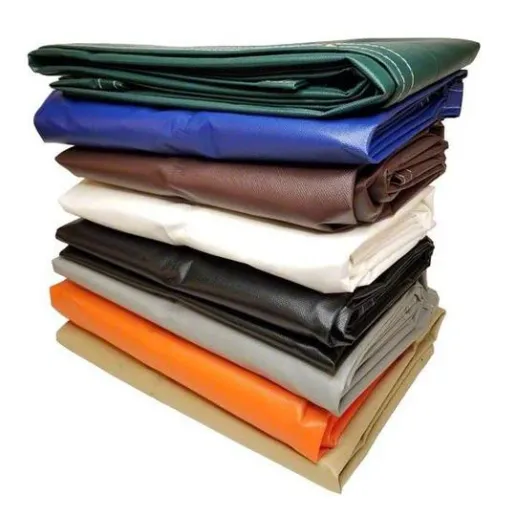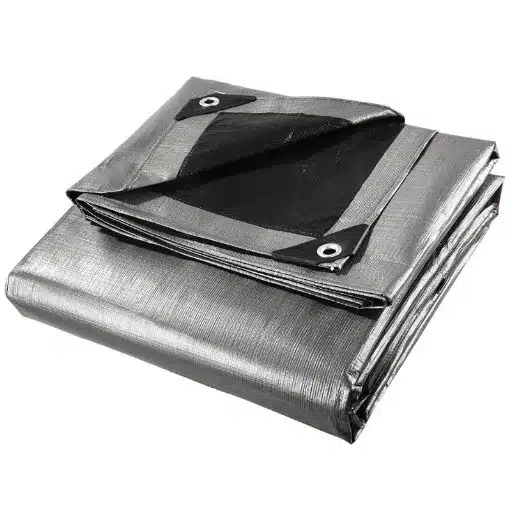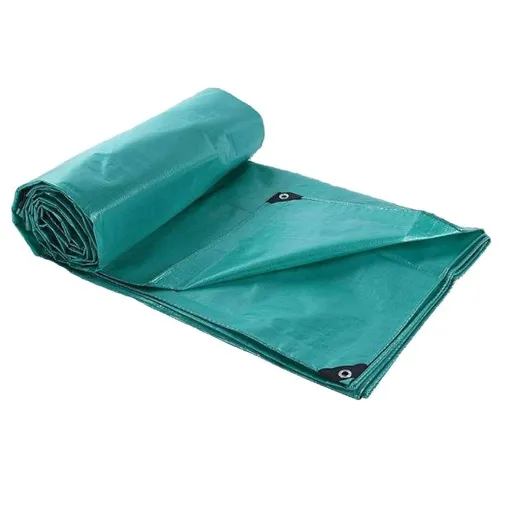For most use cases, the choice of tarpaulin material narrows down to the two bestselling options: canvas and PVC tarpaulin. Each material has its own unique properties and benefits that may make it more appropriate for particular uses. For your particular needs, which one stands out as the best? Do you want a product that is strong, supple, or perhaps the most budget-friendly? Grasping those nuanced differences could truly tip the scales. In today’s article, we’ll delve into what makes canvas and PVC tarpaulins unique, evaluate how they measure up in different use cases, and guide you in making the right decision for your upcoming project. Keep reading to discover the crucial information you should consider before choosing!
Introduction to Tarpaulin Materials
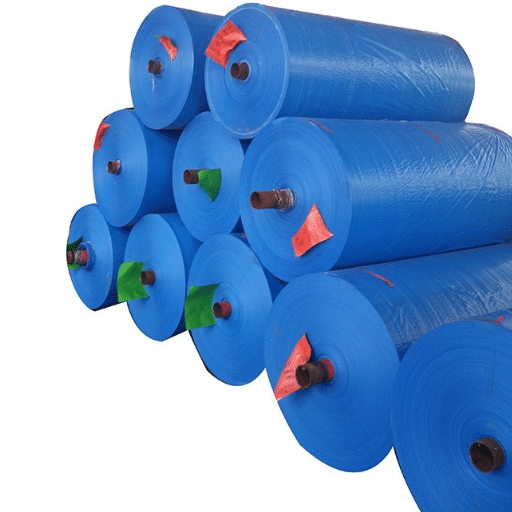
C
What is Canvas Tarpaulin?
Canvas tarpaulin refers to a heavy-duty fabric commonly made from cotton, linen, or both. It is often tightly woven to increase strength and durability. Canvas tarps are frequently waxed or treated with waterproofing chemicals to increase their resistance to water, mildew, and UV light, protecting them for use both indoors and outdoors.
One of the remarkable features of canvas tarps is that they are very breathable, which cuts down on condensation during the covering of items. Additionally, they are eco-friendly as they are reusable and biodegradable. Canvas tarps are widely used in camping, construction, and agriculture because of their sturdy, yet flexible, build.
Contemporary canvas tarp materials can still be treated to sustain modern eco-friendly standards and, at the same time, provide protection against elements, which is essential for safeguarding merchandise and machinery.
P
What is PVC Tarpaulin?
PVC tarpaulin, or Polyvinyl Chloride tarpaulin, is a high-quality, heavy-duty waterproof material formed by laminating polyester fabric with PVC. This kind of roofing offers tremendous toughness, weather resistance, and flexibility, which makes it an indispensable construction material.
PVC tarps have an exceptional ability to endure rain, sunlight, and abrasion, which makes them suitable for outdoor use. They are used for making covers for trucks, tents, and industrial equipment, as well as ponds. More so, the PVC tarpaulins are mildewcide, fire retardant, and sunlight resistant, which increases their functionality and lifespan.
Their strong, multi-faceted performance has made them useful for both industrial and private uses.
Key Differences Between Canvas and PVC
Both canvas and PVC are widely used, but both differ sharply in terms of composition, durability, and use. As a natural fabric, canvas is typically made from cotton or linen and is notable for being breathable and environmentally friendly. Purposes of art, outdoor coverings, and even bags and shoes frequently employ canvas. Nonetheless, it is less sturdy in extreme weather and can use additional treatment to improve its water resistance and lifespan.
In contrast, PVC (polyvinyl chloride) is a man-made product designed for greater durability and resistance to environmental factors. Unlike canvas, PVC is waterproof, UV resistant, and far sturdier against abrasion and chemicals, making it suitable for heavy-duty industrial covers, tarps, and even outdoor equipment protection.
Cost and maintenance envision a further difference between the two. PVC tends to be cheaper and easier to clean than canvas, which needs routine maintenance and cleaning to stay clear of mold and other forms of degradation. Moreover, PVC does not allow air flow, which can be a negative in applications where breathability is critical.
The primary reason for selecting between these materials capitalizes on their utility. Canvas serves best for breathable covering and as a more eco-friendly option. On the other hand, PVC is ideal for use in extreme working conditions that demand greater durability and resistance to weather.
Composition and Manufacturing Processes
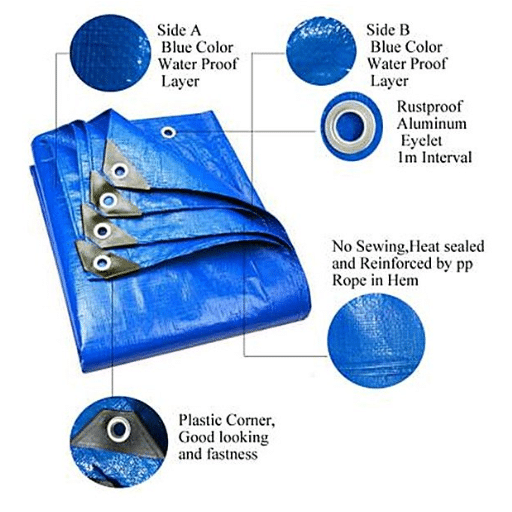
Fabrication of Canvas Tarpaulin
Cotton and linen are the primary components used in the fabrication of traditional canvas tarpaulins, while the modern ones are made with the inclusion of synthetic materials like polyester. Unlike cotton, polyester blends are not woven, which makes the fabric more flexible. Cottons and blends of cotton with other fabrics like polyester are popularly used in the fabrication of tarpaulins. The blends are more preferable as they offer better fabric properties compared to the pure cotton.
Canvas tarpaulins are often made of canvas and treated with wax or a barbeque glaze such as paraffin or polyethylene in order to enhance their weatherproof qualities. Such treatments allow the material to resist mildew, which enables the material to be used in outdoor functions. The incorporation of natural and synthetic fibers makes the tarpaulin ecosustainable and durable.
Fabrication of PVC Tarpaulin
Known also as polyvinyl chloride tarpaulin, PVC tarpaulin is made from synthetic materials to enhance its durability and flexibility. The base fabric is made from high-strength polyester which acts as a core layer that provides tensile strength and tearing resistance. This polyester fabric is then coated or laminated with PVC on both sides, giving the tarpaulin water-proof and SARS (Severe Acute Respiratory Syndrome)-resistant properties.
The PVC is formulated to include plasticizers to increase flexibility, while stabilizers and fire retarders are added to improve the heat and fire safety. PVC tarpaulins also undergo treatment to remove fungal and microbial resistance, further improving their life span in outdoor and industrial usage. The use of such materials makes PVC tarpaulin notable for its versatility, durability, and adaptability in different climates and conditions.
Fabrication of Canvas and PVC Tarpaulin
The production of canvas usually starts with a fiber either natural such as cotton or synthetic such as polyester. This fiber is then tightly woven to obtain a durable fabric. This fabric can be exposed to processes such as dyeing, waterproofing or treatment with coatings to enhance its resistance to water, UV and mildew.
On the other hand, PVC tarpaulins are produced by coating or laminating polyester fabric with polyvinyl chloride layers. The process of PVC coating involves melting and spreading PVC over the fabric to grant it high waterproofing, flexibility and resistance to wear and tear. Hot-melt coating and knife coating, which are advanced methods of coating, are used as a matter of precision and quality control.
The fabrication of PVC and canvas combines the two processes and consists of a bonding process where the canvas base is coated or laminated with PVC by use of special bonders to produce a hybrid. This guarantees that the product will have the tensile strength of the canvas and the impermeability of the PVC. There are new improvements in the fabrication process such as the use of automated coating machines and environmentally friendly chemicals which are gaining popularity because they help lower operational costs.
Durability and Longevity
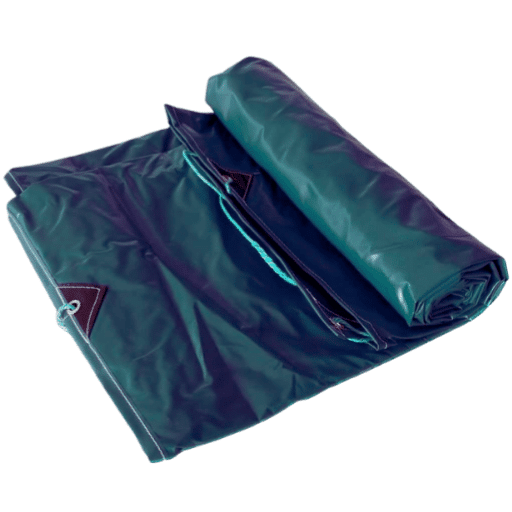
Durability of Canvas Tarpaulin
Canvas tarpaulin is widely used across industries, largely due to its well-known durability. The woven fabric base, when combined with protective coatings such as PVC, effectively resists tearing, abrasion, and other impacts. In recent studies, it was noted that the lifespan of canvas tarpaulins varies weighted by use and exposure to elements, ranging anywhere from 5 to 10 years.
Exposure to elements such as UV radiation, rain, and temperature extremes is a major contributing factor. Modern canvas tarpaulins are, in fact, more dependable than they have ever been due to coating treatments and innovations in anti-fungal agents and UV-resistant finishes. As a result, modern canvas tarpaulins are even more dependable for long-term use.
Durability of PVC Tarpaulin
Versatility in both industrial and personal contexts is one of the drivers of the widespread use of PVC tarpaulins, which are appreciated for their extraordinary durability. The available data from CoStar’s search engine shows that with adequate maintenance, their useful life ranges from 7 to 15 years. The PVC material’s resistance to water, UV radiation, and tears drives their useful life.
Their resilience to physical and weathering stresses has also been increased through the use of advanced manufacturing techniques, such as reinforced mesh layers and improved lamination techniques. To ensure that PVC tarpaulins remain an affordable and durable option over the years, they should be stored properly and cleaned as necessary, which will also help prolong their life.
Maintenance Requirements for Each Material
PVC Tarpaulins
Dirt, mold, and mildew can weaken the material; therefore, PVC tarpaulins should be cleaned regularly to prevent dirt, mold, and mildew buildup. A mild soap and lukewarm water combination should be used for cleaning, which should be followed by air drying to prevent moisture retention. The use of abrasive cleaning tools and those causing damage to the lamination should be avoided.
For long-term storage, the tarpaulin should be dried thoroughly and stored in a cool dry place, away from direct sunlight, to avoid UV degradation. Checking for minor damage such as small tears on PVC tarpaulins should be part of the regular maintenance activities, and damages should be repaired immediately using patch kits.
Canvas Tarpaulins
Continuous wetting of canvas tarpaulins may induce mold growth, which is why these tarps need to be maintained dry. Spot cleaning with mild detergent and soft brush is advisable, and drying after use is necessary. To preserve their waterproofing properties, canvas tarps should be treated with waterproofing agents.
Storage of tarps should be done in an area free from moisture to avoid damage. Because of the wearing out, and tear-prone nature of the tarps’ edges and seams, these areas need continuous monitoring and maintenance, and possible restitching or strengthening.
Polyethylene (PE) Tarpaulins
The care needed for PE tarpaulins is quite minimal, in fact, they can be cleaned with just water and mild soap. The use of sharp objects or scrubbing vigorously, which can harm or puncture the woven fabric, should be avoided. Similar to PVC tarps, PE tarps need to be completely dried prior to storage to reduce the chance of mildew.
Being lighter in weight and less durable, PE tarps require more frequent replacement, especially when exposed to direct sunlight or heavy stress. They should be checked regularly for rips or fraying edges to ensure that they remain in good condition and fit to be used for their intended purpose.
Weather Resistance and Performance
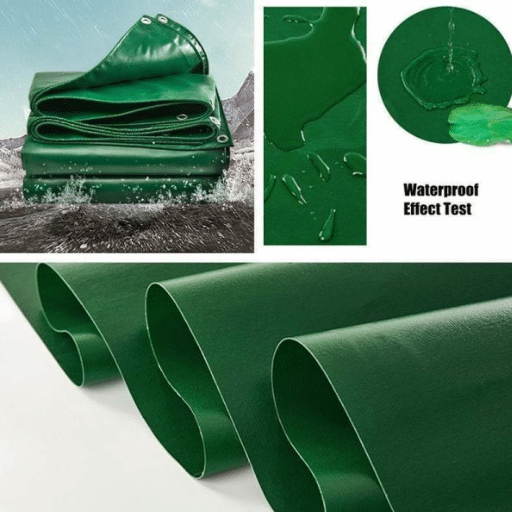
Canvas and PVC Waterproof Features
Both canvas and PVC can be used to achieve waterproof features, but the efficiency of these materials is affected by the type of fabric and the treatment done to it. Canvas is originally a knit fabric and can be made waterproof with wax or silicone treatments for priority covering. The treatment enhances the resistance of the fabric to water. Canvas fabrics treated in this way are good at repelling water, but the treatment may need to be redone after some time.
PVC is considered waterproof because it is a synthetic fabric and is non-porous. Its dependability to be waterproof makes it suitable for tarpaulins, awnings, and covers for outdoor uses. In recent times, PVC has gained popularity because of the improvements made to its leak resistance and the durability of PVC, even for extreme temperatures.
PVC is known to be the most effective in long term water resistance, especially in areas with heavy rain and high humidity. Canvas is appreciated because of its breathability and its eco friendly nature. This makes canvas more preferable in areas that need water resistance and ventilation. Both serve their use. The materials to be used should be based on the environmental conditions, as well as the intended use of the materials.
Breathability and UV Resistance
Both PVC and canvas have their own benefits and disadvantages in breathability and UV resistance. The most recent information shows that PVC is strong in UV resistance, making it suitable for continuous sunlight outdoor exposure without performance degradation. This strength is very useful in outdoor applications in warm regions. PVC is not a breathable material, so in heat-sensitive environments or enclosed spaces, moisture buildup and discomfort is likely.
Canvas has far better breathability than PVC, while its UV protection is weaker as compared to PVC. It is a natural fabric, and This allows better air circulation to reduce heat and create a cooler and comfortable environment. Where the application involves both UV and breathability, some advanced technics like the use of UV-treated canvas may provide a better answer. However, it is dependent on the usage since it considers the level of exposure, climat, and functional priorities of the task.
Mildew Resistance: Canvas vs PVC
The resistance a material has to mildew shows that canvas has an equal level of resistance as other natural materials, whereas PVC is far better than those materials. PVC, as a synthetic material, does not support mildew, mold, or any other form of life due to lack of moisture retention. Due to such properties, it is very well suited for moist or moist-wet areas.
Canvas is far different from PVC and stands at the opposite spectrum. Due to being a natural fiber, it tends to absorb moisture which in turn promotes mildew growth. Even with the advanced modern-day fabrics, canvas may have due to treatments and coatings, the effectiveness of such prevention is largely dependent on the environmental conditions. Moreover, these treatments tend to wear off, necessitating reapplication.
Based on the most recent data available, it is clear that the majority of users look for ways to increase the mildew resistance of canvas products like applying waterproofing sprays and storing in dry areas. On the other hand, PVC is recommended for applications where exposure to moisture is expected. This is because of the low maintenance and durability of PVC products, which are assumed to excel under such environmental conditions. As previously mentioned, the decision between canvas and PVC vastly depends on the application and the environmental conditions for that specific use.
Cost-Effectiveness Analysis
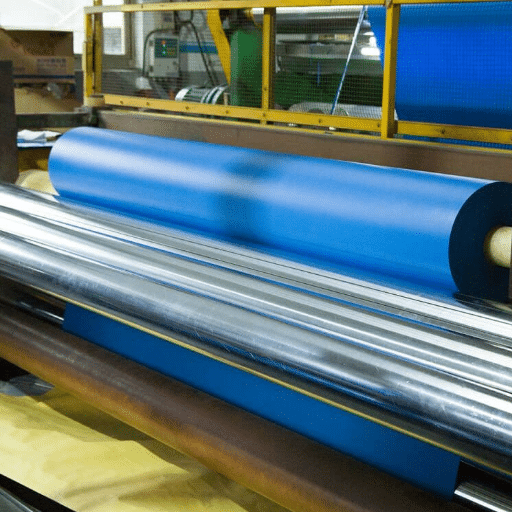
Purchasing Canvas and PVC Tarps: What You Should Know
There’s a marked difference in initial costs when it comes to purchasing canvas and PVC tarps. Canvas tarps are made from blended natural fibers such as cotton and polyester. Because of the natural fiber materials, additional processing to mosquito water resistance, and the labor involved, canvas tarps demand a higher initial purchase price.
As for PVC tarps, which are made from synthetic plastic polymers, they are generally cheaper at the time of purchase. Their lower initial cost is due to the availability of raw materials, the simplicity of their production, and the lack of any additional processing steps. For example, as per market reports, the price per square foot of a basic PVC tarp is roughly 25% to 50% cheaper compared to a similar canvas tarp.
If initial expenses are the primary consideration, then PVC tarps would be the cheaper option. Even so, there is the matter of other significant factors like the tarp’s long-term durability, environmental considerations, as well as maintenance and servicing needed to arrive at the real economical option.
Canvas vs Vinyl Tarps: Evaluating Their Value Over Time
An assessment of the value of the canvas and vinyl tarps over time would include a thorough look into their: durability, maintenance, environmental impact, and special case needs.
A canvas tarp is normally composed of cotton; this, paired with its construction and landscaping and equipment covering applications, makes it quite useful in those fields. It can withstand wearing and punctures, and heavy-duty construction is normally suitable for serious challenges. Nonetheless, a cleaning regimen that includes drying is required to prevent the growth of molds and mildew, and this maintenance is typically required on a regular basis. Depending on how much it’s exposed to and used, a canvas tarp can last an average of 5-10 years with adequate care.
Compared to vinyl tarps, which are covered in PVC and related synthetic materials, vinyl tarps lack in breathability, which may pose a problem in covering items that require airflow to prevent moisture buildup. In terms of covering items and materials, vinyl tarps are well-known for their acid and chemical, UV, and water immersion protection, making them highly preferred for longer-term outdoor and industrial uses. With industry publications, reinforced vinyl tarps may last even a decade or more, especially when used within reasonable conditions. Cleaning also seems less tedious and less requiring of maintenance in comparison to canvas tarps.
From the standpoint of the environment, canvas tarps are more eco-friendly and have an edge since they are biodegradable. The fizzy vinyl tarps are made from PVC materials which, although durable, pose more challenges in recycling and are less sustainable from the environment standpoint.
A decision between canvas and vinyl tarps comes down, in the end, based on the needs and priorities, including the cost over time and the environmental concerns, in addition to the intended application. In relation to cost-effectiveness, the investment in either material is ensured by leveraging a well-maintained tarp, which can maximize and extend utility and the lifespan of the product.
Cost vs Benefits: Selecting the Best Tarpaulin
In evaluating the merits of canvas versus vinyl tarpaulins, the cost-benefit relationship is the most crucial component in determining which is the better option. With respect to search engines, the latest data on tarps reveals that canvas tarps are most often preferred in settings that have to do with agriculture and construction, as well as in outdoor environments requiring eco-friendliness and breathability. The marginal increase in cost over vinyl tarps is offset, from the standpoint of environmental benefits, by their biodegradability and eco-friendly nature.
Vinyl tarps are the most sought after for their water resistance and durability, which makes them the preferred choice in industrial and marine uses. Their initial investment may be lower, but the environmental issues related to PVC production and disposal should be taken into account. Consumers appear to balance the need for durability and water resistance against the ecological impact when choosing vinyl tarps, as suggested by search trends.
In the end, the balance of short-term expenditures and long-term advantages is what determines the outcome. Buyers should be encouraged to look at the particular needs of the application, the environmental aspects, as well as the maintenance effort, in order to get the most value for their money.
Use Cases and Applications
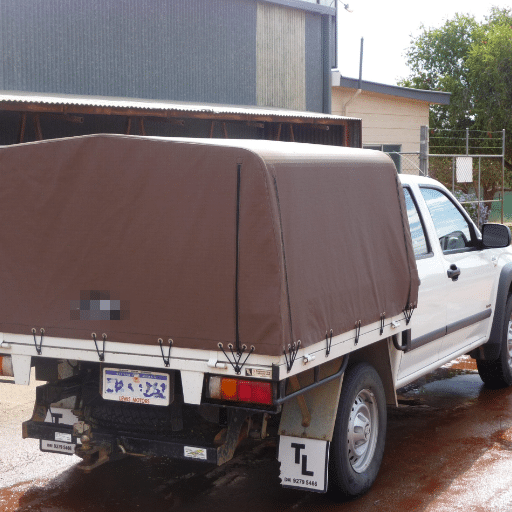
Outdoor Events: Canvas Tarp vs PVC Tarp
Outdoor events require special attention– selecting the proper color, food, and even tarps for the tents. With regard to the tents, there is the choice of the canvas tarp and the PVC tarp. These are some of the key considerations to make in deciding which of the two to go with. Canvas tarps are the preferred choice for tarps shaped from eco-friendly materials during botanic garden and rustic weddings because of their breathability and elegance. In addition, during the heavy rains, canvas tarps will definitely suffer and do not provide the same level of protection as PVC tarps.
PVC tarps are known for their light waterproof structure and weight alongside their durability in severe weather. Concerts and community organization festivals are some of the events where they are used and where strong tarps are needed to provide protection. Although PVC tarps are the less eco-friendly choice, their long life and low upkeep have made them a favorite among event planners with a tight budget. In the end, the choice is dictated more by the conditions of the event and the needs of the event because the two provide vastly different utilitarian and aesthetic benefits.
Industrial Applications of Eco-Friendly and Fire-Retardant Tarpaulins
Due to their eco-friendly materials, fire-retardant fabrics and PVC sheets are widely used and require specialized care. For example, in construction, materials sheets are rainproof and, together with scaffolding, are used for worker safety and to prevent debris from falling.
Moreover, in agriculture, they are used for crops, which are shielded together with tarpaulins for unpredictably weather conditions that can damage them. In addition, the transportation industry uses tar sheets and tarpaulins to cover cargo on vehicles, which is critical to ensure dirt and weather protection.
Based on the data from search engines, there is an inclination to use fire-retardant and UV-protective tarpaulins, which are particularly useful for the manufacturing and logistics industries that require higher safety standards. Therefore, tarpaulins’ multipurpose nature provides basic functionality while offering advanced features to solve specific industrial challenges by its customizability.
Farming: Which Tarpaulin Is Best?
Each farming-related task has its specific tarpaulin needs. Analyzing the recent search data from search engines, the use of UV-protective tarpaulins in farms is on the rise because they protect the farms’ crops and machinery from the harmful effects of prolonged sun exposure. Furthermore, the protection of the harvested crops, as well as the machinery, from heavy rains also increases the demand for waterproof tarpaulins.
As for livestock, the shelters for the animals need to be breathable to provide air, while the tarpaulins used to make them need to be strong enough to withstand a certain amount of wear to ensure longevity. The data ensures that farmers are able to choose tarpaulins fully customisable to their farming needs.
Frequently Asked Questions
Reference Sources
Butler University Blog
Discusses the advantages of PVC tarpaulins over canvas, highlighting better water resistance, UV protection, and durability.
New School Portfolio
Provides insights into the performance of PVC-coated tarpaulins compared to canvas, emphasizing their service life and suitability for harsh conditions.
New School Portfolio
Explores the benefits of waterproof canvas tarps and compares them to other materials like vinyl and PVC for different applications.

